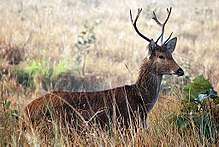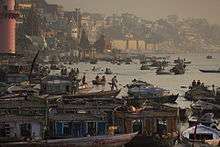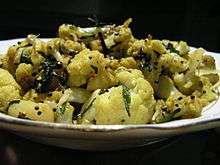Plains (India)
The Plains of India are considered to be the country's heartland. The Ganges (Ganga in Hindi) and Yamuna rivers flow through this region. Major events of India's history took place here. This region contains the large and politically significant states of Uttar Pradesh, Madhya Pradesh and Bihar, and the country's capital, New Delhi. It is the large space of level land that is made by the Ganges River in the northern parts of modern India and the border surrounding areas of the Himalayas. It is an important part of the countries of the Republic of India, Nepal, and Bangladesh. Its space of about 700,000 square kilometers or 270,000 square miles is the home of about 1 billion persons (about one in every seven persons alive today). Its western edge is the Thar Desert; its northern edge is the Himalaya Mountains, the highest mountains on Earth; its eastern edge is the Ganges Delta of Bengal, the largest River delta in the world; and its southern edge is made by the Vindhya and Satpura mountains and Chota Nagpur plateau of middle India.
Cities
Here are nine of the most notable cities.
- 🌍 Chandigarh — the capital city of both the Punjab and Haryana, which was designed by Le Corbusier
Other destinations

- 🌍 Dudhwa National Park, Uttar Pradesh — an expanse of approximately 811 sq km of marshes, grasslands and dense forests representing a very rich ecosystem. It is also part of the Dudhwas Tiger Reserve
- 🌍 Harike Wetland, Punjab — this has a diversity of wetland animals and plants. It was Harike Pattan Bird Sanctuary and is known for its many species of migratory birds. It is habitat for several endangered species such as the Testudines Turtle and Smooth Indian Otter
- 🌍 Satpura National Park, Madhya Pradesh — located in the rugged terrain of the Satpura hills, this park habitat for a large diversity of animals such as the tiger, leopard, wild dog, chital, wild boar and wide variety of birds. On rare occasions, elephants, lions and water buffalo have visited the park.
- 🌍 Sultanpur National Park (Sultanpur Bird Sanctuary), Haryana — this park provides habitat and feeding grounds for many migratory birds such as the Siberian crane as well as the many resident bird species found here
Understand

The Plains, watered by the holy Ganges and its tributaries, are the breadbasket of India. This region is also the Hindi Belt, formerly the Sanskrit belt where the Aryan ancestors of most of today's Northern Indians established themselves in ancient times when Hinduism was developing into the form known today. It is an area of densely populated cities and villages, including the very big cities of Delhi, the nation's capital; Lucknow; Varanasi and Patna. As a result of this area's continuous habitation for thousands of years and the creativity of the people under various dynasties, some of the most famous sights in the world are on the Indian Plains.
Talk
Given that the Plains are the Hindi Belt, Hindi and Urdu are widely spoken in almost all of the states, with the exception of Punjab, where Punjabi dominates. As in the rest of India, English is a very commonly learned second and third language.
Get in

By plane
All major cities in the area have airports. Delhi's Indira Gandhi International Airport is large, and likely to be the point of entry for most foreign visitors to this region. Domestic flights from other parts of India are also commonplace.
By train and bus
Long-distance trains travel from all other parts of India to this region. The same is true of long-distance bus lines.
Get around
There are numerous train connections between the major cities in this region. Domestic flights for longer distances are also possible. Buses also traverse this area.
See
The Plains contain some of the most famous sights in the world. Agra is the home of the Taj Mahal; near Agra is the former royal town of Fatehpur Sikri, which is made out of red sandstone. The Ganges at Varanasi is both a sight and an experience — the crowds of people ritually bathing in the river, the funeral pyres near its banks, the splendid ghats. There are quite a few other places along the Ganges, Yamuna and other rivers sacred to Hindus that are worth visiting. The small town of Khajuraho boasts Tantric temple complexes that some art historians consider to represent the pinnacle of erotic art. The towns of Bodh Gaya and Sarnath are two of the wellsprings of Buddhism; Bodh Gaya in particular has impressive temples. Amritsar's pride and joy is the Golden Temple, the world headquarters of the Sikh religion. And of course there is the capital city of Delhi, which has numerous sights including the Jama Masjid and Qutb Minar, two of the best known examples of Islamic architecture in the country, and the Red Fort.
Do
- For a unique experience and view, take a boat trip on the Ganges.
Eat

This region serves a lot of the North Indian cuisine many foreigners are somewhat familiar with, including tandoori dishes. As this is a wheat-growing area, people eat breads (roti, naan, etc.) often, though rice is also eaten. Much Plains food is hearty and generously and aromatically spiced, though only sometimes extremely heavy in chilis. Vegetarianism is not as prevalent in many of these areas as in Southern India and Gujarat, partly because there are many Muslims and other non-Hindus living in these states, which were influenced by hundreds of years of rule by the Muslim Mughal Dynasty, so it is not hard to find goat, mutton and chicken curries in restaurants, but do not expect to see much beef for sale. Instead, milk products such as yogurt (often in the form of raita, a yogurt-based sauce) and paneer (fresh cheese curd) are used often in a wide variety of foodstuffs.
Drink
Northern India is the land of milk-based drinks such as lassi. Masala chai — tea with milk and a blend of spices — is also a common beverage in this region.